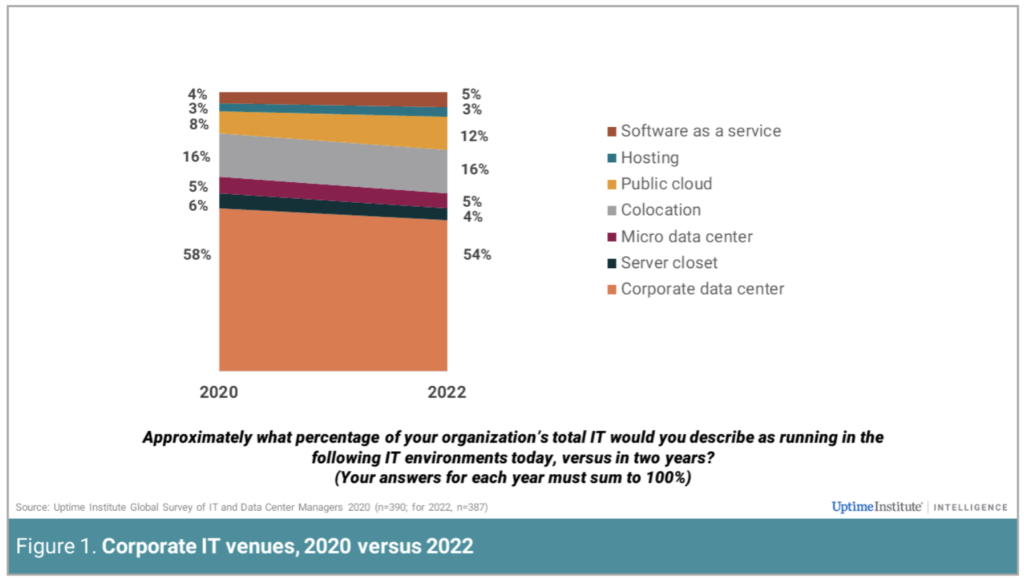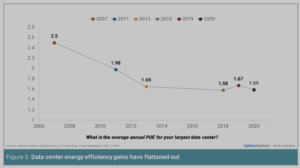Cloud Doubts Mean Datacenters Aren’t Going Away

The death of the enterprise datacenter has been greatly exaggerated, an annual survey finds, adding that on-premises infrastructure is “neither dead nor dying” despite a migration of some critical workloads to public clouds.
The Uptime Institute’s annual datacenter survey released this week finds that more than half of enterprise workloads are expected to remain—secured—in-house through 2022. And despite much hype about moving computing resources to the network edge, Uptime concludes that “edge [computing] is still on the edge.”
As operators continue to stress availability and rack density rises, Uptime’s metric for datacenter energy efficiency has “flatlined.” Meanwhile power disruptions have contributed to more and bigger datacenter outages. Those failures “continue to occur with disturbing frequency, and the bigger the outages are becoming [the] more damaging and expensive,” the Uptime survey concludes.
“You can’t do anything without power,” stressed Andy Lawrence, Uptime’s research director.
Overall, Uptime concludes corporate IT landscape is a “mixed picture,” with capacity expanding to the public cloud along with other third-party providers like colocation centers.
A key metric for the Uptime survey is determining what types of datacenters are being used by enterprises to process and store workloads and data sets. Fifty-eight percent said most workloads remain in corporate datacenters, a total that is projected to decline only slightly over the next two years. Sixteen percent said they are using colocation facilities while public cloud migrations are expected to reach 12 percent of workloads by 2022.
Hence, the survey concludes, “the enterprise-owned datacenter sector, while not necessarily the most innovative, will continue to be the foundation of enterprise IT for the next decade.”
The relatively slow transition of mission-critical applications to public clouds stems from lack of visibility, the survey concludes. The datacenter segment “is fairly risk averse,” said Uptime CTO Christopher Brown. Hence, enterprises have been cautious in embracing relatively opaque public cloud services.
“They don’t know what under-the-hood looks like,” Brown noted during a briefing on the survey findings. “People want to be masters of their own domain.”
Steady improvements in datacenter power usage effectiveness, or PUE, over the last decade have stalled. “Datacenters are all about availability,” Brown said. For now, operators have “squeezed out most of the efficiencies from datacenters we can get.”
Datacenter expertise also remains hard to come by despite the growing availability of AI and other automation tools. The survey of about 850 IT managers found that datacenter staffing shortfalls are worsening. Meanwhile, automation won’t reduce datacenter staffing requirements any time soon, respondents said.
“The datacenter sector is one of the fastest growing [technology] sectors on the planet,” added Rhonda Ascierto, Uptime’s vice president of research. Still, she said, the sector lacks the visibility necessary to attract talent.
The Uptime survey was conducted in March and April 2020. A separate survey will gauge the pandemic’s impact on datacenter operators. Most operators have transitioned from “emergency response mode” to an “interim normal phase,” Lawrence said, which is expected to extend for up to a year.
Other survey results have emerged, indicating the pandemic’s negative impact on datacenter operations like storage infrastructure. A vender survey released by StorONE found that 20 percent of organizations can’t access their datacenters, limiting the ability to address physical hardware failures. Another 20 percent said they have restricted datacenter access to only allow work on critical instances.
Related
George Leopold has written about science and technology for more than 30 years, focusing on electronics and aerospace technology. He previously served as executive editor of Electronic Engineering Times. Leopold is the author of "Calculated Risk: The Supersonic Life and Times of Gus Grissom" (Purdue University Press, 2016).












